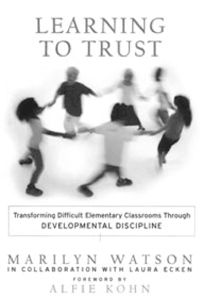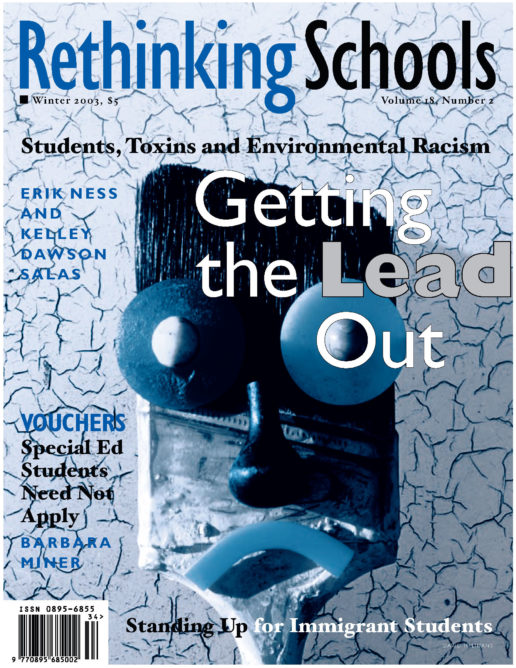Reviews 18.2
BOOK
Rethinking Classroom Discipline
By Bob Peterson

Learning to Trust: Transforming Difficult Elementary Classrooms Through Developmental Discipline, by Marilyn Watson in collaboration with Laura Ecken. (Jossey-Bass, 2003). 318 pp. $29 (hardback).
Classroom discipline is one of the most daunting challenges for teachers. It’s something that no teacher ever really masters, as each new class comes with new challenges and possibilities. Over the years, I’ve attended workshops and read numerous articles and books on the subject, but nothing has inspired me as much as Marilyn Watson’s new book, Learning to Trust.
I am skeptical about books on discipline. Too often the classroom scenarios are unreal and the suggested techniques overly simplistic. When books on discipline come into the Rethinking Schools office for review, most end up on the shelf for long-term storage. But this book is different.
In the foreward, writer Alfie Kohn poses two different ways educators approach classroom practice. Some ask, “How can we get these kids to obey?” Others ask, “What do these kids need, and how can we meet those needs?”
Watson and her colleague Laura Ecken are educators who ask the second question. They promote what they call developmental discipline-“discipline that derives its power from the quality of the teacher-student relationship and its efficacy from the caring quality of the total classroom environment.”
“Unlike most of the familiar approaches to classroom discipline that focus on controlling children,” they explain, “developmental discipline focuses on building a caring classroom community and a nurturing, trusting partnership with each student. These partnerships do not eliminate the need for adult control, but more frequently they involve teaching the social, emotional, and moral skills and understandings that children have not yet developed.”
Watson, who recently retired from Development Studies Center of Oakland, Calif., has taught preschool through college and has written extensively on children’s social and moral development. In Learning to Trust, she chronicles two years of Laura Ecken’s inner-city third-grade classroom in Louisville, Ky. Drawing heavily on the descriptive journal entries of Ecken, Watson documents the good, the bad, and the ugly as Ecken struggles to build a “caring community of serious learners.”
Teachers know too well that creating a community of learners is no easy task in this society. Children are bombarded with commercial messages that value things over humans. They’re mesmerized by television that defines personal interaction as a series of put downs and sexual innuendoes. And many are addicted to video games that glorify violence. Yet somehow, Ecken seems to pull off the near impossible using developmental discipline.
Attachment Theory
Developmental discipline is based on the attachment theory, which contrasts sharply with the two main theories that have shaped educational approaches to discipline and classroom management: Skinner’s behaviorist learning theory and Freud’s psychoanalytic theory. Attachment theory holds that the nature of early attachment relationships affects the quality of one’s attachments throughout life. A child whose early relationship with a caregiver (usually the mother) is positive and secure learns to trust others to provide needed care. Children whose primary relationships don’t meet basic needs will have insecure attachments and tend to devalue themselves and mistrust others.
Even though it would have been helpful if Watson had examined the potential misuse of this theory-for example, someone using it to blame a child’s family history for classroom misbehavior-her interpretation of the theory demonstrates an uncompromising belief that even the most difficult discipline problems can be resolved without resorting to carrot-and-stick approaches.
Watson and Ecken argue that children’s social and emotional development is as important as their cognitive development. Developing trust and the capacity for empathy among students, for example, would serve as a welcome antidote to the test-based plague currently gutting quality educational programs.
Teaching social and emotional skills is not easy, however. At one point during the two-year story, Ecken gets so frustrated with her classroom’s inability to get along while playing competitive games she decides to prohibit such games, even kickball, concluding that the “demands of competition were well beyond her students’ emotional abilities.”
While I haven’t resorted to such radical measures, the description resonated so forcibly with me that it helped me realign the physical education program that I am in charge of this year by putting greater emphasis on cooperative games and activities.
Building Trusting Relationships
The book details how Ecken struggles to build trust in her relationship with her students and among students. For example, she explicitly instructs students on how they are to introduce and conduct themselves in a variety of partnering activities. She uses “question circles” where students share answers to various questions like what they like to do when it rains, or sharing their favorite books or cartoons. Students change partners after each pair answers a question, making students interact with many classmates.
She creates graphs and Venn Diagrams with her students to learn of their similarities and differences. (Venn Diagrams are two overlapping circles with each one representing one particular characteristic-e.g. students who have a sister, those with a brother; the area where both circles overlap contains those who have both a sister and brother.) Ecken also has lunch regularly with different students to better acquaint herself with them through ordinary conversations.
Not only are the activities and techniques useful to teachers, but the actual language Ecken uses with her students is worth repeating-to one’s own students. Ecken tells her class that “friends listen to friends, friends don’t embarrass friends, and friends forgive.” And she constantly reminds her students that they are a “caring community of serious learners.”
Watson and Ecken do not make it sound easy, because it isn’t. Students with weak social skills regularly challenge Ecken. Her responses don’t always work, and she vents her frustrations in the book. This makes the book all the more useful and readable. For example, after half a year of class meetings and role modeling around a variety of social skills, Ecken returns to school after a day’s absence to learn that her students treated the sub terribly. Ecken’s response is to recommit herself to teaching those social skills. She also paints a vivid picture of how she let her own class know how disappointed she was-turning the fiasco into a learning experience.
The real strength of the book comes in its treatment of issues such as autonomy, responsibility, belonging, and competence. Ecken recognizes that she must walk a fine line between students’ need for autonomy and their capacity to make responsible decisions. She wants to provide students with as much independence as they can handle, and attempts to do so by making the environment manageable-creating structures that limit their opportunity to misbehave. At the beginning of the year, for example, this means creating and discussing with her students
procedures for routine activities such
as leaving the classroom, transitioning between subjects, or participating in class meetings.
Ecken recognizes that her most difficult students experienced lots of punishment in their earlier lives and it “neither helped them become caring and responsible nor had it kindled their love of learning.” Instead, her goal is to engage all of her students as partners with her to improve their academic learning and to behave in kind, fair, and responsible ways. The book demonstrates that this is a very difficult task, and time consuming, but ultimately one worth pursuing if we believe that we can help all our students.
In groups and in individual conversations, Ecken teaches her students to analyze situations and to be more reflective of their own goals and behaviors. For example, one technique she uses is to have students use “self talk.”
Through modeling and reminders, she encourages students to talk to themselves and give themselves instructions about how to behave instead of acting without thinking. This technique helps her students realize that they are in charge of their own behavior and it gives them a way to pull themselves together and do what they really know they should do. I started off the year using this technique, showing students how to tell themselves in their minds what they should be doing. In some cases, I give my students a visual cue to remind them they should engage in self-talk. Watson calls self-talk “the first line of defense against going out of control.”
Policy Implications
At the end of the book, Watson discusses a series of policy implications. She explains that developmental discipline is a strong argument for both small class size and having teachers stay with students for more than one year, through looping or other means.
While this book deserves accolades, it could have been even more powerful had it dealt with three issues even more explicitly: the relationship of curriculum to discipline, the social function of discipline, and the matter of race.
There is no explicit description of Ecken’s teaching philosophy and techniques. Much is implied, and some appears in the cracks of the book. But my experience as a student and as a teacher is that engaging curriculum that relates to the lives of the students is key in reducing discipline problems. While the careful reader could conclude that Ecken approaches teaching this way, in these times of scripted curriculum and direct instruction, the book could have been more powerful had it been more explicit on the importance of engaging, activity-based, student-centered curriculum.
The book also avoids a discussion of how hierarchical forms of organization and rigid discipline fulfill a broader social role of preparing students to behave compliantly in larger social structures replete with class, race, and gender inequalities.
And the book seems to skirt the issue of race, a source of tension and bias in many schools. While Ecken’s class is multiracial, and at least one section of the book recounts a classroom conversation about prejudice, there are a couple of places that the issue should have been dealt with head on. For example, when Watson describes how teachers’ own childhood experiences might impact their view of certain kids, I wish she had probed deeply about race, home language, and class prejudice.
These minor weaknesses pale when compared to the central power of the book, which convincingly demonstrates that there is an effective alternative to gold stars and ever-escalating punishments.
Such alternatives require indefatigable efforts by teachers to develop the social and emotional skills in students. But it is only through such approaches to discipline that teachers will be able to build “caring communities of serious learners” and meet the needs of their students.

